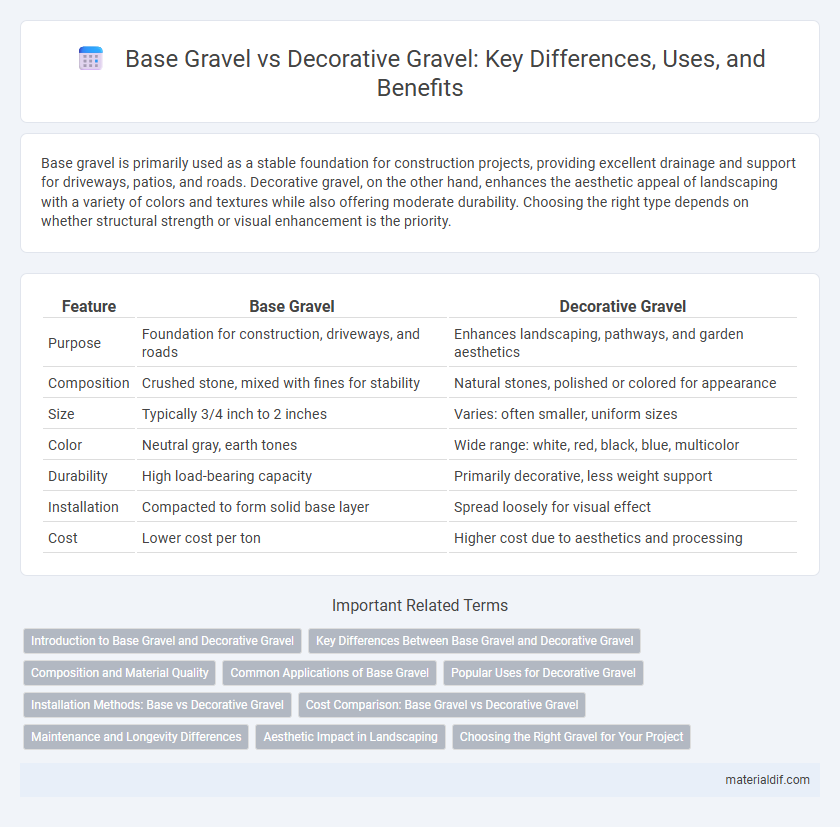Base gravel is primarily used as a stable foundation for construction projects, providing excellent drainage and support for driveways, patios, and roads. Decorative gravel, on the other hand, enhances the aesthetic appeal of landscaping with a variety of colors and textures while also offering moderate durability. Choosing the right type depends on whether structural strength or visual enhancement is the priority.
Table of Comparison
| Feature | Base Gravel | Decorative Gravel |
|---|---|---|
| Purpose | Foundation for construction, driveways, and roads | Enhances landscaping, pathways, and garden aesthetics |
| Composition | Crushed stone, mixed with fines for stability | Natural stones, polished or colored for appearance |
| Size | Typically 3/4 inch to 2 inches | Varies: often smaller, uniform sizes |
| Color | Neutral gray, earth tones | Wide range: white, red, black, blue, multicolor |
| Durability | High load-bearing capacity | Primarily decorative, less weight support |
| Installation | Compacted to form solid base layer | Spread loosely for visual effect |
| Cost | Lower cost per ton | Higher cost due to aesthetics and processing |
Introduction to Base Gravel and Decorative Gravel
Base gravel, composed of crushed stone and angular particles, provides strong compaction and drainage for construction projects, serving as a stable foundation under roads, driveways, and patios. Decorative gravel features smoother, rounded stones in various colors and sizes, enhancing the aesthetic appeal of landscaping, garden paths, and outdoor spaces. Choosing between base and decorative gravel depends on functional requirements like support and drainage versus visual enhancement and surface texture.
Key Differences Between Base Gravel and Decorative Gravel
Base gravel is primarily composed of crushed stone or coarse aggregates designed to provide a stable foundation for construction projects such as driveways and roads, offering excellent drainage and load-bearing capacity. Decorative gravel features smoother, aesthetically pleasing stones in various colors and sizes, used mainly for landscaping, garden paths, and ornamental purposes. The key difference lies in their function: base gravel emphasizes structural support and durability, while decorative gravel prioritizes visual appeal and surface texture.
Composition and Material Quality
Base gravel primarily consists of crushed stone or recycled concrete with angular edges, providing high stability and excellent drainage due to its compactable nature. Decorative gravel typically features smoother, rounded stones such as river rock or pea gravel, selected for aesthetic appeal rather than structural support. Material quality in base gravel is engineered for durability and load-bearing capacity, whereas decorative gravel emphasizes color, texture, and uniform size to enhance visual landscaping effects.
Common Applications of Base Gravel
Base gravel is primarily used in construction projects such as roadways, driveways, and foundation support due to its excellent compaction and stability properties. This type of gravel provides a solid base layer that enhances drainage and prevents shifting or settling of overlying materials. Its angular, crushed stone composition makes it ideal for sub-base layers under concrete slabs and asphalt pavements.
Popular Uses for Decorative Gravel
Decorative gravel is commonly used in landscaping projects such as garden pathways, patio borders, and mulching around plants due to its aesthetic appeal and variety of colors and textures. Unlike base gravel, which provides structural support for driveways and construction, decorative gravel enhances visual interest and helps with soil moisture retention. Popular applications include accentuating flower beds, creating rock gardens, and designing low-maintenance ground covers.
Installation Methods: Base vs Decorative Gravel
Base gravel installation involves compacting layers of crushed stone to create a stable foundation for driveways, walkways, or patios, ensuring proper drainage and support. Decorative gravel installation focuses on aesthetic appeal, typically laid over a weed barrier without compaction, allowing for easy rearrangement and maintenance. Proper preparation for base gravel includes grading and leveling, while decorative gravel often requires minimal site prep to highlight texture and color variety.
Cost Comparison: Base Gravel vs Decorative Gravel
Base gravel, typically composed of crushed stone or recycled concrete, is more cost-effective, costing around $10 to $30 per ton, making it ideal for foundational uses like driveways and pathways. Decorative gravel, often made from polished or colored stones, ranges from $30 to $100 per ton due to its aesthetic appeal and variety of textures. Choosing between base and decorative gravel depends on budget constraints and whether the priority is structural support or visual enhancement.
Maintenance and Longevity Differences
Base gravel, composed of crushed stone, offers superior stability and drainage, reducing maintenance needs and prolonging the life of driveways and pathways. Decorative gravel, often made from smoother, rounded stones, requires more frequent upkeep such as raking and replenishing due to displacement and weathering. The durability of base gravel makes it ideal for structural support, while decorative gravel prioritizes aesthetic appeal but demands higher maintenance to retain its appearance.
Aesthetic Impact in Landscaping
Base gravel serves as a foundational layer in landscaping, providing stability and drainage, but offers limited aesthetic appeal due to its coarse texture and muted colors. Decorative gravel enhances the visual impact with a variety of colors, shapes, and sizes, creating attractive pathways, garden beds, and borders that complement plants and outdoor features. Selecting decorative gravel can significantly elevate the overall design by adding texture and contrast, while base gravel remains primarily functional.
Choosing the Right Gravel for Your Project
Base gravel offers superior stability and drainage, making it ideal for foundational layers in construction and driveways, while decorative gravel enhances aesthetic appeal in landscaping with various colors and textures. Selecting the right gravel depends on project goals, weight-bearing requirements, and desired visual impact. Understanding the functional properties of base gravel versus the visual benefits of decorative gravel ensures durability and design harmony.
Base gravel vs decorative gravel Infographic

 materialdif.com
materialdif.com